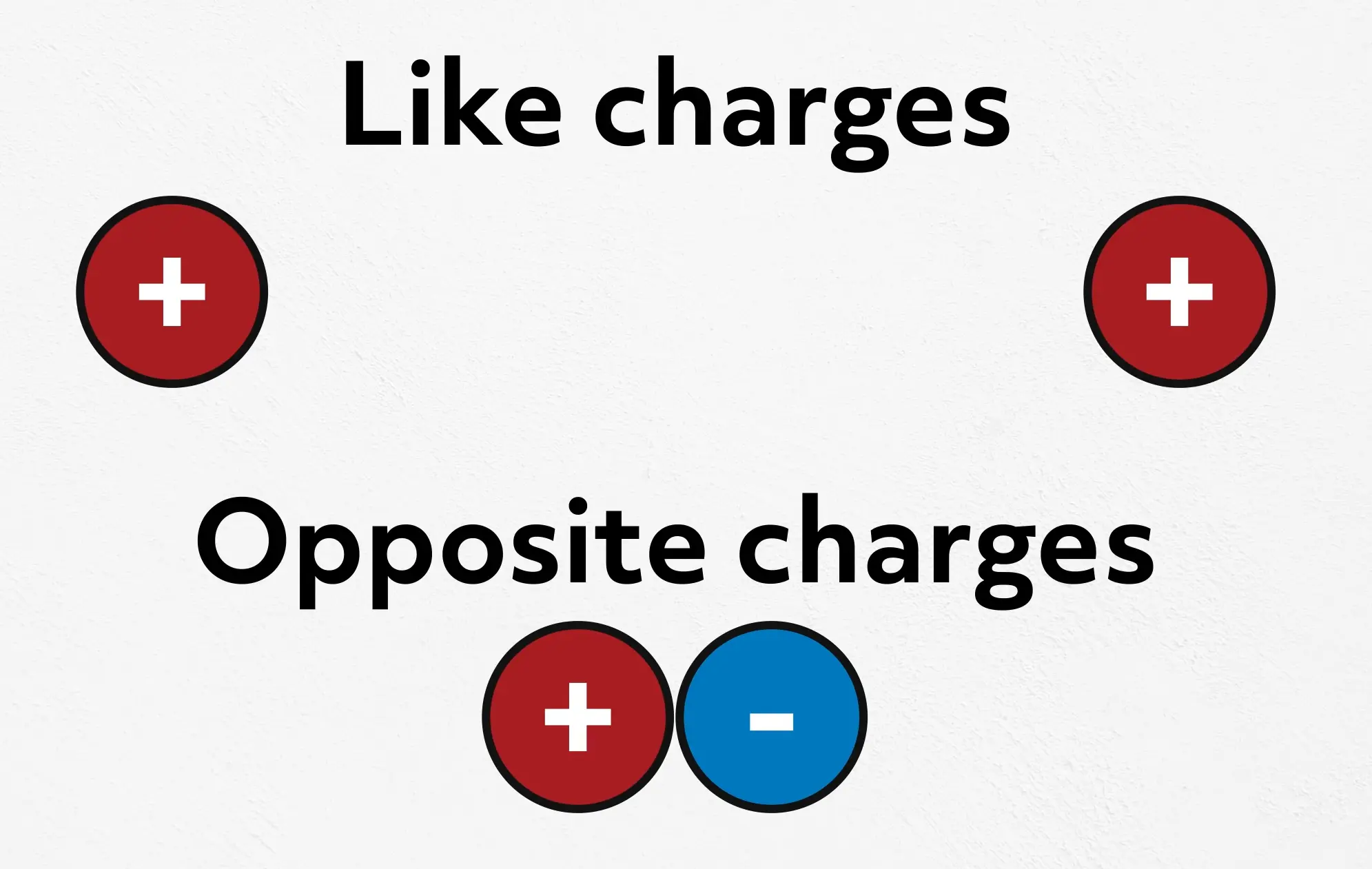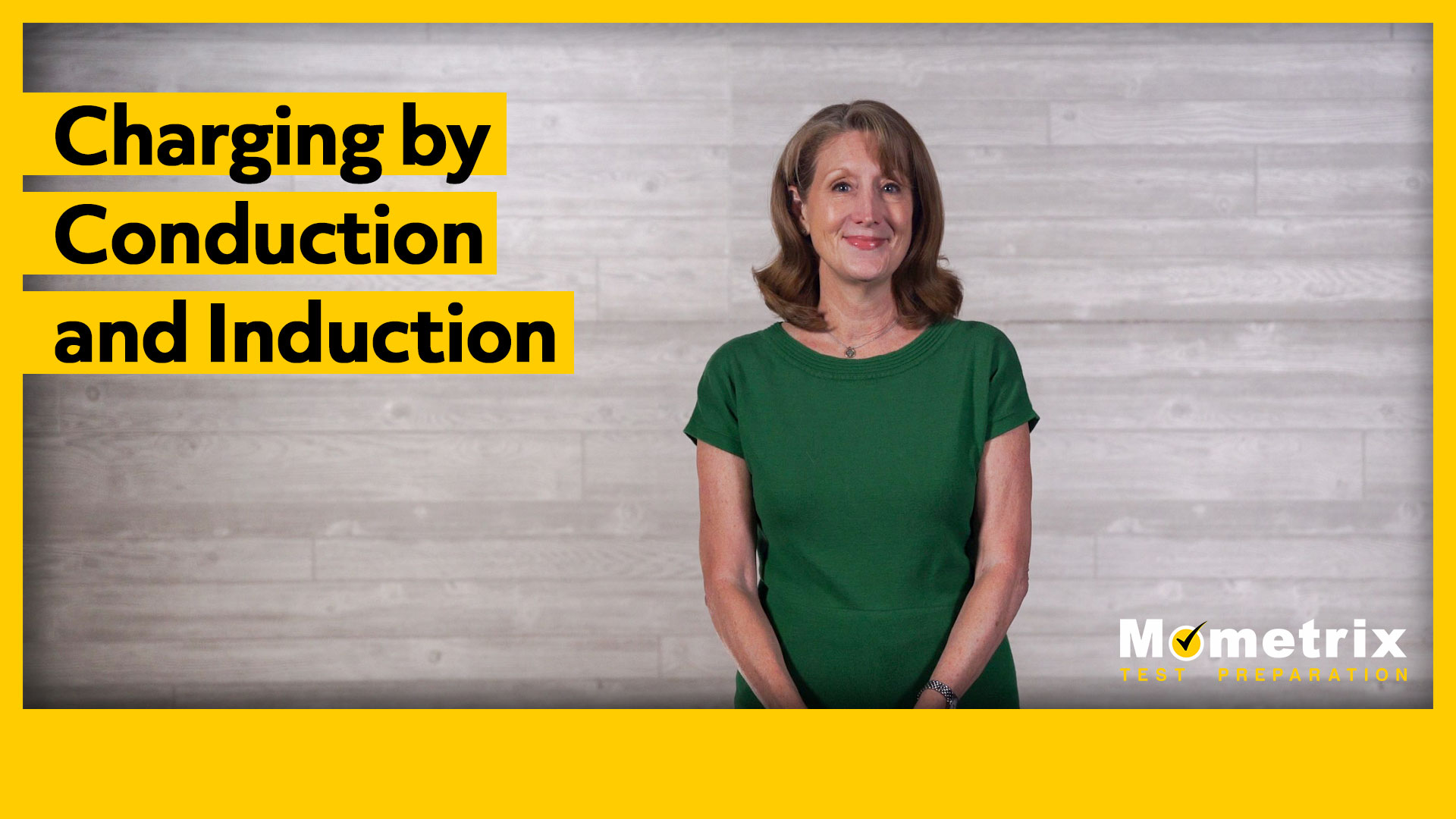
Hi, and welcome to this video on charging by induction and conduction! In this video, we’ll review the behavior of electric charges and discuss how to charge objects using the methods of induction and conduction.
First, let’s review what a charge is and how it works.
Charge
The particles that make up everything can be either charged or uncharged. Charged particles include protons, which are positive, and electrons, which are negative. These individual particles each have an amount of charge that is defined as the fundamental unit of charge. Uncharged particles, like neutrons, have no charge at all, not even a little bit, so they do not impact electric interactions in any way.
All electrically charged particles exert a force on all other electrically charged particles, aptly named the electric force. The electric force causes like charges to repel each other and opposite charges attract each other. The closer the two charged objects are to each other, the stronger the repulsion or attraction is between them.

In an atom, the nucleus is composed of neutrons and protons, which are basically in a fixed position, while the electrons exist in a sort of cloud around the nucleus. As such, the number of electrons in an object changes when it builds up charge. An object with extra electrons has negative charge and one with less than the normal amount has positive charge. Each type of atom differs in the number of particles it contains and in conjunction with a few other factors, will vary in how easily electrons can move about. This means that materials made from different atoms can have very different electrical properties.
In a conducting material, some of the electrons are free to move around. Since they can move freely and are all like charges, they repel each other throughout the material and collect on the surface. This property of a conductor makes it easier to affect the charge of the conductor. Metals typically make good conductors and as such are typically the material of choice in current-carrying wires.
An insulator, on the other hand, is a material consisting of atoms with electrons that are secured more tightly to their atoms, but it is still possible to affect the charge of an insulator. For example, if a neutral glass rod is vigorously rubbed with a cloth, the cloth can remove some of the outer electrons from the rod, leaving it with a net positive charge.
So, now let’s talk about ways to charge an object. How do you charge an object using conduction?
Conduction
In order to charge a neutral conductor by conduction, you must touch that object with a charged object. It’s actually pretty simple! Let’s think about an example. Here we have a neutrally charged conducting sphere (metal) sitting on a neutrally charged insulator. As you bring in a charged glass rod closer to the sphere, the free electrons on the sphere are attracted to the positive charge and move to that side of the sphere, leaving the other side with a net positive charge.
Then, when the positively charged rod touches the sphere, the electrons move onto the rod, making it less positively charged. Once the rod acquires a net neutral charge, any remaining electrons will stop moving onto it and redistribute themselves on the sphere.
Taking the rod away, you are left with a positively charged sphere!
If, instead, you wanted to obtain a negative charge on the sphere, you could touch the sphere with a negatively charged object. The extra electrons on the object will want to spread out as much as possible and jump over to the neutrally charged sphere when touched, leaving it with a net negative charge afterward.
Grounding
Now let’s talk about grounding. Remember the insulating base for the sphere we mentioned in the last example? This base was mentioned to ensure that the sphere does not become grounded while being charged by the rod. When an object is grounded, there is a readily available supply of electrons to transfer into or out of the object through the grounding source. We call it grounding because, technically, if an object is touching the ground, it will be grounded. However, any metal object would also work, or even your skin if you are also touching the ground. In fact, shocking a device through static electricity can be prevented by grounding yourself. You can do this by touching a piece of metal to your skin, thereby neutralizing yourself.
Induction
When we use induction to charge an object, there are a couple of ways to do it. One way involves using a grounding source. Let’s go back to our positively charged rod and neutral metal sphere. If you place a finger on the sphere as a grounding source, the sphere now has a freely flowing source of electrons if needed.
Now, if we bring the positively charged rod near the sphere without touching it, the extra electrons on the conducting sphere will congregate in the area near the rod due to the attraction by the positive charges. Meanwhile, the electrons from the grounding source (which is you, if it is your finger on the sphere) will fill in the now positively charged half of the sphere that was left by the electrons attracted to the rod. They will fill that half of the sphere until that part is neutral again. Now, we have a sphere that is partially negative and partially neutral.
But what happens when we remove the finger and the charged rod? The electrons will then spread out again as much as possible due to repulsion of like-like charges. However, more electrons were added to the sphere by the grounding source, causing an overall negative charge on the sphere.
Unlike charging by conduction, using the positively charged rod resulted with a negatively charged sphere when charged by induction. With a negatively charged rod, we would have ended up with a positively charged sphere, since the negative charge would have repelled electrons in the area near the rod.
We could also charge by induction without a grounding source. Imagine, instead, that we had two neutral spheres touching each other and a positively charged rod. When the positively charged rod comes near (not touching) one of the spheres, an excess of free electrons will move to the sphere that the rod is closest to. Then, moving the two spheres apart leaves us with a negatively charged sphere (the one near the positively charged rod) and a positively charged sphere.
So, the difference between charging by induction and conduction comes down to the contact of the neutral object and the object used to charge it. Conduction requires direct contact, while induction does not.
Review
Now that we’ve learned all about induction and conduction, let’s test our knowledge with a couple of questions!
1. In the last example, the two spheres that were in the process of being charged by induction were moved apart while the rod was still nearby. What would have happened if we first moved the charged rod away and then moved the two spheres apart?
- The electrons would redistribute themselves equally among the two spheres, resulting in the original neutrally charged configuration.
- We would get the same result, one negative and one positive sphere.
- Both spheres would be negatively charged.
- Both spheres would be positively charged.
2. Sometimes rubber balloons pick up extra electrons from other objects. What happens if a charged balloon falls on and sticks to a metal cup and is then pulled away?
- The cup will be positively charged by induction.
- The cup will be negatively charged by induction.
- The cup will be positively charged by conduction.
- The cup will be negatively charged by conduction.
That’s all for our video on charging by induction and conduction! Thanks for watching, and happy studying!
